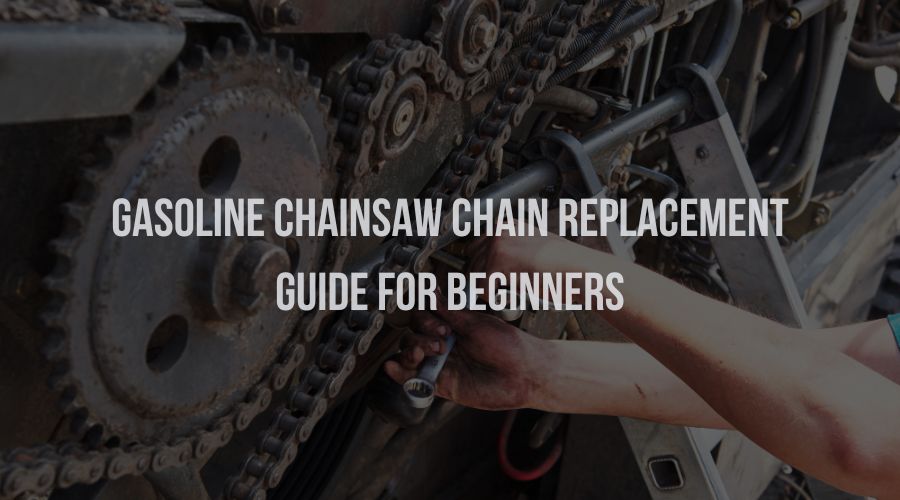Introduction
When it comes to maintaining your garden tools, knowing how to replace a chainsaw chain is a valuable skill for any DIY enthusiast or homeowner. Gasoline engines power many chainsaws, making them essential hand tools for various outdoor tasks. Whether you’re a seasoned power tools enthusiast or a beginner just starting, this step-by-step chainsaw chain replacement guide will help you keep your garden tools in excellent working condition.
Why Replace the Chainsaw Chain?
Before we dive into the replacement process, let’s briefly discuss why it’s essential to replace a chainsaw chain. Over time, the chain on your chainsaw can become dull, damaged, or worn due to regular use. A well-maintained chain ensures efficient cutting and enhances the safety of your power tools.
Tools and Materials You'll Need
Before we start, gather the necessary tools and materials:
1. Replacement Chainsaw Chain
Ensure it matches the specifications of your chainsaw model.
2. Gloves
For hand protection.
3. Safety Goggles
To shield your eyes from debris.
4. Screwdriver (if required)
Some chainsaws may require a screwdriver for chain replacement.
5. Chainsaw Wrench
Usually provided with your chainsaw.
6. Workbench or Sturdy Surface
For stability during the process.
7. Bar and Chain Oil
Essential for proper lubrication.
Step-by-Step Replacement Process
Step 1: Safety First
Safety should always be your top priority when working with power tools. Start by taking these precautions:
- Put on safety goggles to protect your eyes.
- Wear gloves to shield your hands.
- Make sure the chainsaw is turned off, and the engine is cool.
- Work in a well-ventilated area, away from flammable materials.
Step 2: Disconnect the Spark Plug Wire
To prevent accidental starts, disconnect the spark plug wire from the spark plug. This is a crucial safety step before any maintenance work.
Step 3: Examine the Chainsaw
Take a moment to examine your chainsaw. Locate the chain tensioning mechanism, which is usually positioned near the bar and chain cover.
Step 4: Loosen the Bar and Chain Cover
Depending on your chainsaw model, you may need to use a screwdriver or the chainsaw wrench to loosen the nuts or screws securing the bar and chain cover. Once they’re loose, remove the cover.
Step 5: Remove the Old Chain
Carefully lift the old chain off the bar. Pay attention to the direction of the cutting teeth; they should be pointing forward. This is essential for proper cutting performance.
Step 6: Clean the Bar and Sprocket
Before installing the new chain, it’s a good practice to clean the bar and sprocket. Remove any sawdust or debris using a brush or a rag. A clean working surface ensures smooth operation.
Step 7: Install the New Chain
Place the new chain onto the bar and ensure it aligns with the sprocket. Ensure that the cutting teeth are facing forward, as this is crucial for effective cutting.
Step 8: Tension the Chain
Proper chain tension is essential for safety and performance. Use the chain tensioning mechanism provided with your chainsaw to adjust the chain’s tension. It should be snug on the bar but not overly tight. Refer to your chainsaw’s manual for specific tensioning instructions.
Step 9: Reattach the Bar and Chain Cover
Carefully position the bar and chain cover back onto the chainsaw. Ensure that the tension adjustment pin fits into the hole on the bar.
Step 10: Tighten the Nuts or Screws
Using the screwdriver or chainsaw wrench, tighten the nuts or screws on the bar and chain cover securely. Be cautious not to over-tighten, as this could affect the chain’s performance.
Step 11: Lubricate the Chain
Before using the chainsaw, it’s essential to ensure proper lubrication. Fill the bar and chain oil reservoir according to your chainsaw’s recommendations. Proper lubrication reduces friction and extends the life of your chain.
Step 12: Reconnect the Spark Plug Wire
Finally, reattach the spark plug wire to the spark plug. This step is crucial to ensure safety during your chainsaw’s operation.
Step 13: Test the Chainsaw
Start your chainsaw and test the new chain to ensure it operates smoothly. Listen for any unusual sounds and observe the chain’s movement to ensure it’s cutting correctly.
Conclusion
As a power tools manufacturer and supplier of garden tools, industrial tools, construction tools and other supplies, HR Tools & Engineering understands the importance of maintaining your power tools equipment. Replacing a chainsaw chain is a fundamental skill for any DIY enthusiast or homeowner. By following this step-by-step guide, you can ensure that your gasoline-powered chainsaw remains a reliable and efficient garden tool.
Remember, safety always comes first when working with power tools. Don’t hesitate to consult your chainsaw’s manual or seek assistance from a professional if you encounter any difficulties during the chain replacement process. Proper maintenance not only prolongs the life of your equipment but also enhances its performance, making your gardening tasks easier and more enjoyable.
